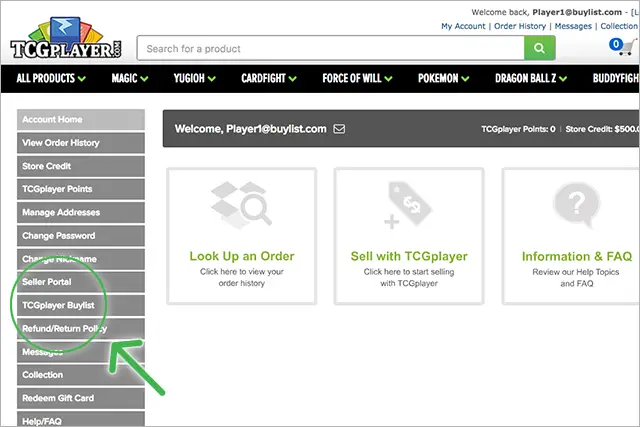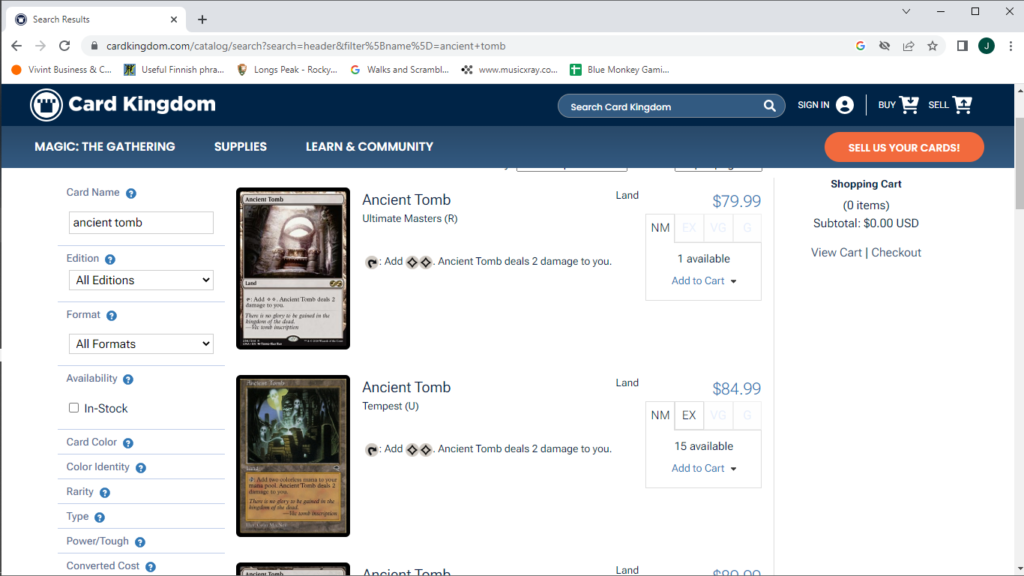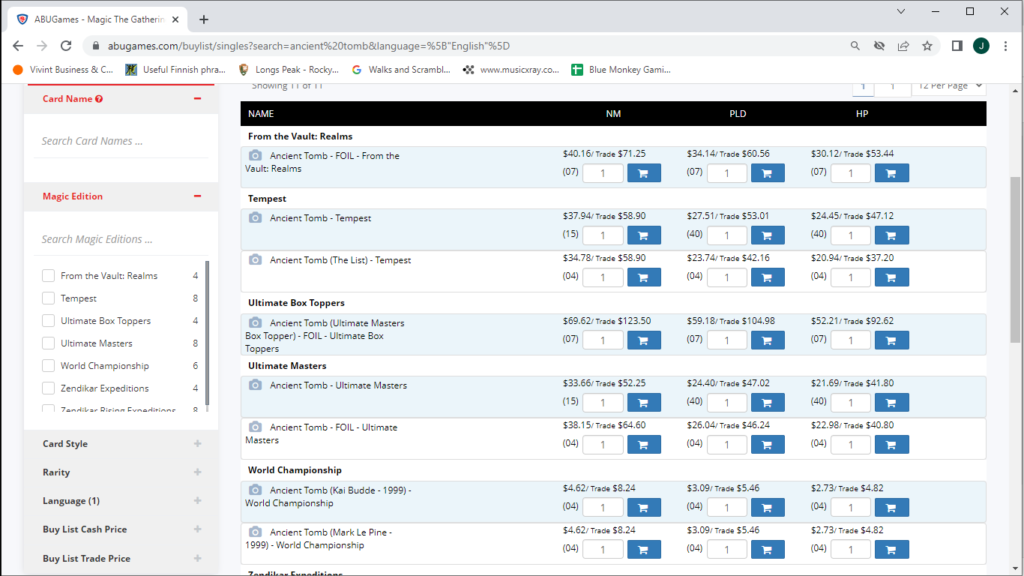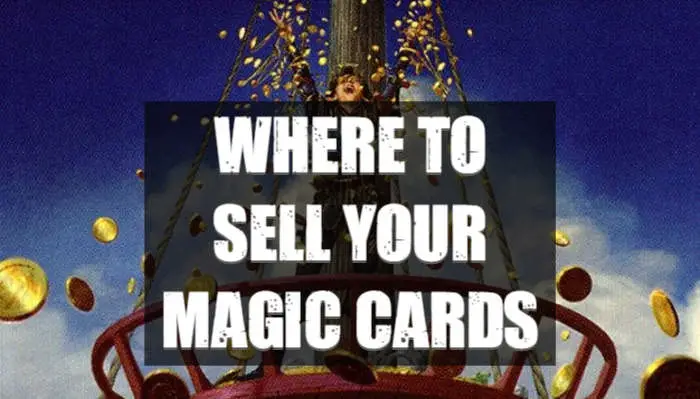Maybe you have cards laying around that you’re not using and not planning to use. Maybe you just cracked a pack and pulled a really expensive card that you don’t need.
There are countless reasons why MTG players might want to sell cards. Finding the right place to do so, however, can be tricky.
In this article, I’ll go over all of the best places to try if you’re wondering where to sell magic cards.
| Best Overall | TCG Player Trade-In |
| Runner Up | CardKindom Buylist |
| Best Alternative | Facebook Groups |
While most platforms are similar in their overall approach, they are by no means all created equal. Read on to learn how to get the best price for your cards with the least hassle.
Table of Contents
- How We Tested
- Test Results
- TCG Player Trade-In
- Cardkingdom Buylist
- Star-City Games
- ABU Games
- Other Options For Selling Cards
- End Step
How We Tested
I’ve been selling Magic cards across multiple platforms for years. From that experience, I’ve learned that choosing the right one makes a huge difference. But I didn’t just rely on my past experiences. For this article, I decided to do some hands-on research. I chose six of the most popular cards in Magic across various formats and checked all of the popular selling platforms to see which one offers the most. Here are the cards I chose:
At the time of writing, these six cards are worth about $225 according to TCG Player and mtggoldfish.
RELATED: What Is The Value Of Magic: The Gathering Cards?
Test Results
So what did the most popular buylists offer for them? I won’t keep you in suspense.
| Actual Value of Cards: $225 |
| TCG Player Trade-In: $144 |
| Star City Games Buylist: $139 |
| Cardkingdom Buylist: $120 |
| ABU Games Buylist: $106 |
As you can see TCG player and Star City Games offered the most, while Cardkingdom and ABU games offered the least. The initial offer price, however, isn’t the only thing you should consider when looking at where to sell magic cards.
Read on for a full review of each of these popular selling platforms. I’ll also give my picks for the best alternatives, in case you don’t want to use buylists at all.
TCG Player Trade-In
If you’re looking to sell your cards quickly and easily while still getting a fair price, TCG Player Trade-In is the place to go.
For the six cards from my list, they offered 65% of the total average-value, which I feel is quite fair. If you consider that selling through the regular TCG Player marketplace incurs a 10% fee, you’re basically getting 75% percent of the total possible value.
Furthermore, when selling on regular marketplaces, it can take quite a while to sell multiple cards at the average price. If you want to sell quickly, you’ll probably need to price your cards competitively.
All this is to say that selling through TCG Player Trade-In is really an awesome deal for anybody who wants to get rid of cards quickly.

Overall, the interface was simple and easy to use. You search for the card you want to sell, you find your specific copy, you add the number of copies, and the card appears in your cart.
With that being said, the search feature wasn’t as easy to use as some of the other websites. Mainly because it shows the art for every single version of the card you searched. This means you have to do a lot of scrolling and sifting to find the correct version. This could be helpful in some cases though, like if you’re not super familiar with MTG cards and need the art to help you recognize which version you have.
In any case, the inconvenience of the interface wasn’t a big deal and doesn’t outweigh the positives of TCG Player.
Another positive of TCG Player is that they’re known as being pretty fair when it comes to card grades. This means it’s unlikely they’ll downgrade your cards as long as you grade them realistically yourself.
With that being said, some users did report unfair downgrading, so make sure you check the “contact me before downgrading” box just to be safe. Otherwise, they’ll sell your cards automatically for the highest offer per the downgraded condition.
Overall, the good of TCG Player Trade-In far outweighs the mediocre. And, while it’s always a good idea to shop around for the best prices for your specific cards, we recommend you start at TCG Player.
Cardkingdom Buylist
Next up is the Cardkingom buylist. CK is one of the most popular sites people land on when looking at where to sell magic cards. And while they might not have offered the most for my six test cards, I still think they deserve the runner-up spot. Let me explain why.
Cardkingdom is well known for giving a generous 30% increase if you choose to trade your cards in for store credit instead of cash. So if you take the $120 they offered for our six research cards, we could instead choose to get $156 in-store credit. This makes CK the perfect place to sell your cards if you’re planning on using the money to buy more cards.

Also, Cardkingdom is incredibly easy to use. They have the best interface out of all of the sites I reviewed. No hassle. No headache. Just straight down to business.
Also, while it didn’t necessarily show in the results of our test, Cardkingdom has some of the best prices out there, especially for older, higher-end cards. If you have cards to sell, checking Cardkingdom’s buylist is a great idea.
RELATED: The Best Lands In MTG: A Complete Guide
Star-City Games
I must admit, SCG’s buylist prices really surprised me during my research. I had always thought of them as being less competitive than Cardkingdom and TCG Player. And maybe that was the case in the past, but Star-City Games has really stepped it up recently.
The main flaw with SCG is that they usually aren’t buying obscure cards. Also, their prices tend to drop quite a lot with condition.
With that being said, however, if you have popular staples that are Near-Mint, Star-City Games is one of the very best options out there.
ABU Games

ABU Games Buylist had the worst pricing out of all of the sites I reviewed. As such, I can’t really recommend them as somewhere to sell magic cards. However, it never hurts to check. And if you do decided to look into ABU Games prices for your cards, you’ll at least find a simple easy-to-use system.
The one true positive of ABU Games’ buylist is that they’re the only website I found that accepts non-English language cards. The prices, however, were even worse for these cards. Still, if you have lots of non-English cards and you want to sell them quickly, ABU Games could be a good option.
Other Options for Selling Magic Cards
Buylists are super convenient and surprisingly fair. If you’re willing to put in a little extra time and effort, however, you can earn more money for your cards by selling on marketplaces instead of to them. Let’s go over some of the best options for where to sell magic cards outside of buylists.
Facebook Groups
This is my personal favorite way to sell cards. Two of the best groups in my opinion are “MTG Sick Deals” and “THE MTG Buy/Sell/Trade” groups. A quick Facebook search should bring you to them rather quickly.
These groups feature large communities of people who are all looking to buy or sell cards. It’s common and easy to be able to sell your cards for 85% of their market value per condition. And, if you’re in a hurry, listing them for 80% is sure to lead to quick sales.
So let’s assume we listed all six of our test cards on a Facebook group at 80% of their value. I’m confident that, since they’re staples, all six of those cards would sell at that percentage in less than two days. The result: we would get somewhere around $170.
Pretty sweet, right?
There are, however, a decent bit of downsides to using these groups. I’ll list a few.
- It can be difficult to sell at first. These groups use a “reference” system to ensure that traders are trustworthy. When you first start, and you have no past references, it can be hard to find willing buyers who trust you enough to do the deal. This is easily remedied, however, by offering to accept a secure payment method that gives buyer protection. That leads me to my next point.
- It’s possible to get scammed when selling. If you accept certain payment methods, it’s possible, however unlikely, that the buyer receives your card, files a complaint with the payment processor, gets a refund and keeps your card. This isn’t common, but it certainly happens. And it’s something to watch out for. Remember, just trust your instinct when buying/selling online, and don’t do anything if you’re unsure.
- It can be a hassle. Be prepared to make a post with pictures of your cards. You’ll need to research prices on your own. And you’ll need to deal with the buyers directly, usually messaging through Facebook.
- You’ll need to ship cards to multiple buyers. You probably won’t be lucky enough that one person buys all of your cards. That means you’ll need to prepare multiple shipments and send them off separately. This takes time and can also eat into your profits.
With all of that being said, it’s really up to you whether or not it’s worth the hassle for an extra 15% or so. If you plan on selling a lot of cards, and you have some time on your hands, I would strongly recommend using Facebook groups.
eBay
One of the oldest and most popular places where people go to sell magic cards is eBay. Despite it’s popularity, eBay comes with quite a few downsides. Basically, everything negative I had to say about selling on Facebook groups, aside from the difficulty getting started, is also true for eBay.
It’s a lot of work making listings. It’s possible, though unlikely, to get scammed as a seller. And you’ll need to ship each card individually.
The pricing is also pretty competitive on eBay, meaning your less likely to fetch 100% market value. Additionally, eBay charges a hefty 12% commission for trading card sales.
eBay isn’t all bad though. It can be a nice option if you want to try your hand at an auction. If you have a highly sought after card, bidding wars can sometimes drive the price up higher than you expect.
Another good thing about eBay is that, if you price competitively, your cards are likely to sell quickly.
After it’s all said and done, usually, when I sell on eBay, I ended up taking home around 85% of the cards market value. Less if I want to sell quickly.
Local Game Stores
If you live in a city, there’s a good chance there’s a local game store, or LGS, nearby. Most game stores will buy your MTG cards at around 50% to 60% of their value. So for our six example cards, you could expect to get somewhere around $120.
Selling to an LGS is probably the most convenient way to get rid of your cards. There’s no need to package them, no trips to the post office, no waiting around, and no surprise downgrades. It also saves you a bit of money, since envelopes/boxes, tape, and tracked-shipping usually costs around $4 per shipment.
An LGS is also a good option if you have lots of cards and you don’t know how to value them yourself. If this is the case, I would strongly suggest to go through your cards and learn the value yourself using online recourses. But if you really don’t have the time for that, taking them to an LGS is probably your best alternative.
The main downside with selling cards to an LGS is price. There are some game stores out there that give very fair offers, and some that give insultingly low offers. It all depends on the store. You’ll typically get a bit less money from an LGS, however, than you will from selling to a top buylist like TCG Player.
Another downside, is that a lot game stores are only looking for popular cards, since those are the only ones they’re likely to be able to resell. This means if you have older, more obscure cards, you’re likely to get a low offer, or to not get an offer at all.
End Step
Whether you have tons of cards or just a few, whether you want to sell as quickly as possible or you want to take your time and maximize profit, the perfect selling-platform is out there. I hope this article has helped you find it.
Until next time, I wish you the best of luck with all of your MTG endeavors.
